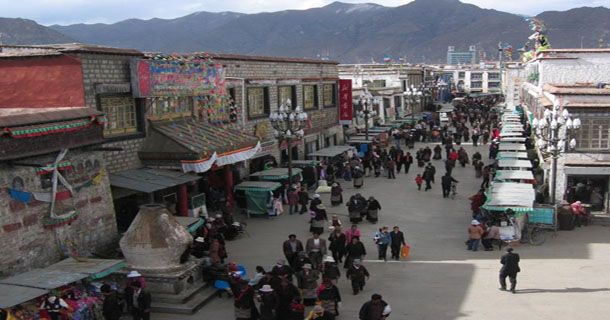Traditional Tibetan homes near Lhasa will be torn down and replaced with modern Chinese designs. Costs will in part fall on the residents with reports suggesting that a contribution of 200,000 Chinese Yuan (over $31,000 or £20,000) is expected from each homeowner. This mandatory project is scheduled for 2016, beginning with Tagtse, Lhundrub, and Meldro Gongkar Counties.
Every homeowner in the affected area must register for the project whether they are receiving a government subsidy or not.
One Tibetan homeowner commented “We are being forced to accept and support the plan without any choice, our own house is in very good shape and doesn’t need reconstruction.” The same source reported that homeowners have been promised the return of their keys to the properties on completion of the project. However Tenzin Dharpo, writing for www.Phayul.com, has expressed doubts over these promises, recalling previous instances of land grabs, forceful buyouts of land and enforced demolition of Tibetan homes.
China has faced growing global criticism over its modernisation policies. In 2013 the modernisation of a sacred Buddhist area around Bharkor market in Lhasa sparked outage. The area is located near the UNESCO protected Jokhang temple. Protestors see this as a policy of obliterating the living culture of Tibet. The modernisation projects are designed to attract tourists, with shopping malls and modern Chinese architecture replacing traditional buildings and sacred monuments.
Speaking to the South China Morning Post in 2013, Tibetan writer Tsering Woeser criticised the project: “Lhasa is being destroyed by excessive commercial development. Lhasa doesn’t exist for only tourists, there are real people who live here and it’s also a religious place.”
Other modernisation projects within China include the conversion of Lijiang in Yunnan and Hunan city into tourist cities. Both projects have since been derided as poor decisions.
Tashi Kyi, aged 55, self-immolated on August 27 this year in protest against Chinese modernisation within Tibet. She died a day later in a “new socialist village house provided by Chinese authorities as part of a relocation project in Sangchu County, Gansu province.
Elsewhere, over 900 people have been left homeless after demolition projects in North Western China’s Qinghai province.





 Print
Print Email
Email